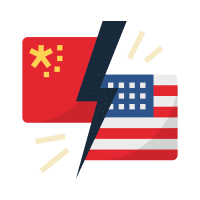Why a China Slowdown Will Not Hurt That Much
After three decades of explosive growth, China’s economy is slowing, sending jitters across global financial markets.
So if China stumbles into a hard landing, how bad will the rest of the world fall?
According to HSBC economist, Frederic Neumann, a slowdown in the Chinese economy is “not exactly the end of it all.”
Possible clues to China’s fate could be gauged from how the world reacted to Japan’s economic malaise, he reckons.
At the end of the 1980s, Japan’s contribution to global gross domestic product was about the same as China does today.
While the Japanese economy has failed to muster meaningful growth since then, the world “sailed on with barely a blip in the 1990s” after Japan’s boom and stumble in the decade before, Neumann noted in a report.
China’s share of the world’s growth in terms of purchasing power parity has jumped to well over 16 percent from 10 percent in the past decade while its share of global gross domestic product (GDP) in U.S. dollar terms has also tripled in the same period to just under 15 percent last year .
“So, if Chinese demand stumbles, would this knock out world growth? Not necessarily. Take the example of Japan in 1989 when the bubble burst. At the time, its share of global U.S. GDP was a touch above 15 percent. The subsequent slowdown, however, didn’t push the world to the brink.”
China imports have grown dramatically but as a major export hub, but the share of retained merchandise imports in China’s GDP is lower than Japan’s today, wrote Neumann.
A significant share (30 percent by some estimates) of China’s imports are components used for exports and thus not subject to swings in local demand, Neumann believes.
“From this perspective, then, China may not be quite as important a global growth driver as often thought.”
Chinese economic growth has slowed steadily since 2010. On Friday, Standard & Poor’s Ratings Services (S&P) estimated that the Chinese economy grew by 6.8 percent in 2015, slowing to 6.3 percent this year.
“In our view, the risk in China is not that growth will tank in a hard landing, but that the authorities will keep growth too high for too long, shrinking their space for policy maneuver and increasing the number of impaired assets and making the economy more vulnerable to a shock ,” Paul Gruenwald, S&P chief economist for Asia Pacific, said in a webcast.
The Chinese government publishes regular targets for annual GDP growth. At the moment, it is aiming for growth of at least 6.5 percent per year until 2020.
However, Gruenwald said that GDP growth should be “dethroned” as the all-important target for China.
“It shouldn’t be a guarantee (hitting the GDP target)… We, at S&P, would prefer a lower rate of growth that is more sustainable,” he said.
Neumann listed three caveats to his assessment that a China slowdown was “not exactly the end of it all”:
- Business cycles are more synchronized today than they were in the 1980s, so a Chinese slowdown may matter more.
- The rest of the world looks a lot wobblier today than it did in the later 1980s or early 1990s.
- China, given the investment-centered nature of its growth, is a larger buyer of commodities than Japan ever was; raw material exporters are certainly suffering already.
Gruenwald added that more financial market volatility was in the offing for Chinese stock markets, following the turmoil last year and at the start of 2016.
“The authorities are obviously transiting from a state-led economy… they need to communicate with the market. Trust needs to be earned… Markets tend to assume the worst, which leads to volatility,” he said.
Despite concerns about China’s financial markets, the country is a net saver, which limits direct exposure for foreign investors, argued Neumann.
China is also unlikely to aggressively lower the value of the yuan.
“In fact, China may be more insulated financially thanks to capital controls than Japan was.”
By Huileng Tan & Katy Barnato January 15, 2016 in CNBC


